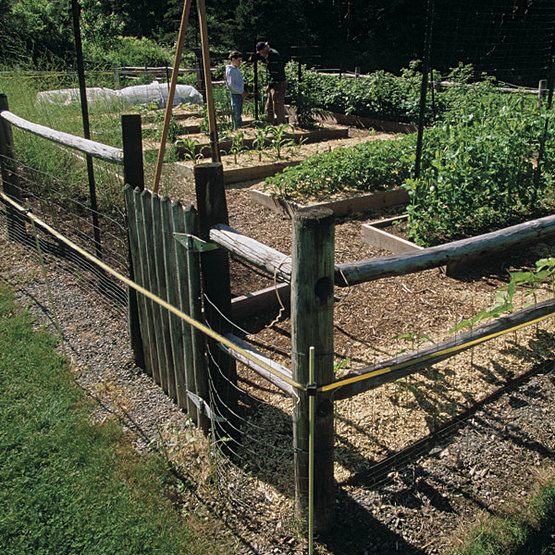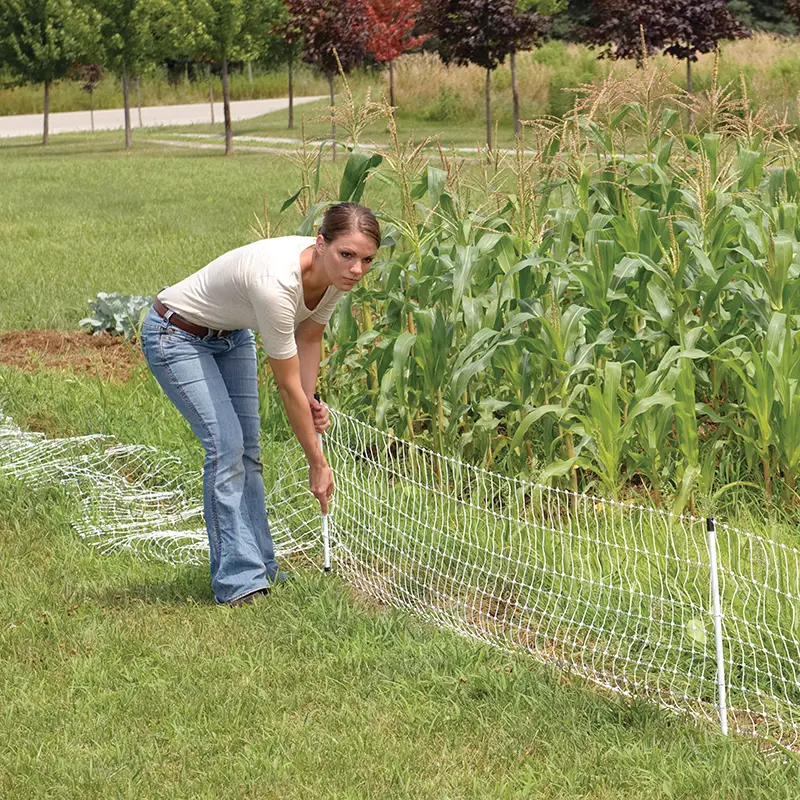Imagine walking into your garden one morning, cup of coffee in hand, only to find your plants nibbled down to the stems. Frustrating, right?
This is where electric fences for gardens come into play, offering a modern solution to an age-old problem. You’ve put time, energy, and love into cultivating your green space, and it’s only fair you protect it from unwanted invaders. Whether it’s rabbits, deer, or other critters, an electric fence can be your garden’s best line of defense.
But is it safe? Is it effective? And how exactly does it work? These are the questions you might be asking yourself. We’ll dive deep into everything you need to know about electric fences for gardens, helping you decide if it’s the right choice for your precious plants. Stay with us, and discover how you can keep your garden flourishing and secure.
JUMP TO TOPIC
Benefits Of Electric Fences
Electric fences keep gardens safe from animals, protecting plants and flowers. They offer a cost-effective way to maintain garden integrity. Easy to install and adjust, electric fences are a practical solution for garden security.
Electric fences are not just for keeping livestock contained. They offer remarkable benefits for garden owners, creating a secure and efficient environment for both plants and humans. Whether you’re an experienced gardener or just starting out, understanding the advantages of electric fences can elevate your gardening game. Let’s explore how these fences can transform your garden into a safe haven.Enhanced Security
Electric fences provide a heightened level of security for your garden. Unlike traditional fences, they deter intruders with a harmless but effective electric pulse. This feature ensures that your precious plants remain untouched by unwanted visitors. Imagine the peace of mind you’ll feel knowing your garden is protected day and night. An electric fence acts as a vigilant guard, making your garden less appealing to potential trespassers. Have you ever worried about neighborhood pets digging up your flower beds? With an electric fence, those worries can be a thing of the past.Wildlife Deterrence
Gardening is a joy until wildlife starts nibbling away your hard work. Electric fences serve as a strong deterrent to wildlife, keeping animals like deer, rabbits, and raccoons at bay. This allows your plants to thrive without becoming a midnight snack. You might think that living near a wooded area makes it impossible to protect your garden from animals. However, with an electric fence, you create a boundary that wildlife respects. This means more produce for you and less frustration over damaged plants.Cost-effectiveness
Electric fences are surprisingly cost-effective. They require less maintenance than traditional wooden or chain-link fences, saving you time and money. Additionally, their longevity ensures you won’t need frequent replacements. Are you worried about the initial investment? Consider the long-term savings. An electric fence can reduce the need for expensive pest control measures and plant replacements. Plus, many systems are DIY-friendly, allowing you to install them without professional help, which further cuts costs. Incorporating an electric fence into your garden plan can lead to more fruitful harvests and fewer headaches. As you weigh your options, think about the security, wildlife deterrence, and cost-effectiveness of electric fences. Are you ready to give your garden the protection it deserves?How Electric Fences Work
Electric fences are practical solutions for garden protection. They keep unwanted animals out and safeguard your plants. Understanding how they work can help you decide if they are right for your garden.
Basic Components
Electric fences consist of several parts. The first is the energizer. This device powers the fence by sending electrical pulses. Wires carry these pulses around the garden. Posts hold the wires in place, maintaining structure. Insulators prevent the electricity from grounding out. These components work together to create a barrier.
Mechanism Of Action
Electric fences operate through deterrence. The energizer sends a quick electric pulse through the wires. Animals approaching the fence feel a mild shock. This sensation is unpleasant but not harmful. The shock teaches animals to avoid the fence. Over time, they learn to stay away. This mechanism ensures effective garden protection.
Types Of Electric Fences
Electric fences safeguard gardens with options like wire, tape, or netting. Wire fences offer durability and high voltage. Tape fences provide visibility and flexibility. Netting fences are ideal for small animals, offering effective protection. Each type caters to specific garden needs, ensuring safety and peace of mind.
Electric fences offer a reliable solution for garden protection. They deter unwanted animals, keeping your plants safe and thriving. Choosing the right type of electric fence depends on your garden size and specific needs. Below, explore various types of electric fences ideal for different garden settings.Permanent Fences
Permanent fences are durable and long-lasting. They are ideal for large gardens that require constant protection. These fences use strong materials and require professional installation. Once set up, they provide consistent security for your garden. Maintenance is minimal, ensuring peace of mind throughout the year.Portable Fences
Portable fences are flexible and easy to move. They suit small gardens or temporary setups. You can install them quickly without professional help. These fences allow adjustments as your garden changes. They are lightweight, making them convenient for seasonal use.Solar-powered Options
Solar-powered fences are eco-friendly and cost-effective. They harness the sun’s energy, reducing reliance on electricity. Ideal for gardens in sunny areas, they offer sustainable protection. Installation is straightforward, and they operate without monthly bills. Solar-powered options are perfect for gardeners seeking green solutions.Installation Process
Installing an electric fence for your garden might seem daunting, but breaking it down into manageable steps makes it straightforward. The key to a successful installation lies in careful planning and precise execution. Let’s explore the process, from assessing your site to selecting the right equipment and following a detailed guide.
Site Assessment
Start by evaluating the layout of your garden. Consider the size and shape of the area you want to protect. Take note of any obstacles like trees or buildings that might affect the fence line.
Understand your garden’s specific needs. Are you keeping pets in or wildlife out? This will determine the height and strength of the fence. A thorough assessment ensures that you choose the most effective setup for your needs.
Equipment Selection
Once you have a clear picture of your site, it’s time to gather your tools. You’ll need a fence charger, wires, posts, and insulators. Choose a charger that matches your fence’s length and the power source available.
Consider the materials for the posts and wires. Metal or fiberglass posts are durable, while polywire is lightweight and easy to handle. Insulators prevent electricity from grounding out, so they’re a must-have for any electric fence.
Step-by-step Guide
1. Plan Your Fence Line: Use a tape measure to mark where the fence will go. Ensure it’s a closed loop for efficiency.
2. Install the Posts: Place them at intervals of about 8-12 feet. Use a post driver for easy installation.
3. Attach Insulators: Fix them to the posts at your desired height. This keeps the wire from touching the posts directly.
4. Run the Wire: Start at the charger location and work your way around. Ensure it’s taut and secure it with the insulators.
5. Connect the Charger: Follow the manufacturer’s instructions for safe and effective setup. Ensure the system is grounded properly.
6. Test the Fence: Use a voltage tester to check the entire perimeter. Make sure there are no breaks or shorts in the line.
How do you feel about installing your own electric fence? It’s empowering to protect your garden with just a few tools and some know-how. Plus, it can be a fun weekend project that provides peace of mind all year round.
Safety Considerations
Electric fences for gardens are popular. They keep unwanted animals out. Safety is crucial when using them. Understanding safety measures ensures protection for all. Learn more about voltage levels, signage, and accident prevention.
Voltage Levels
Electric fences use voltage to deter animals. The voltage must be safe for humans and animals. It should not cause harm. Typically, fences use low voltage. Low voltage gives a mild shock. It is enough to keep animals away. Regular checks are needed. This ensures the voltage is correct. Equipment must be well-maintained. Faulty equipment may increase risk.
Proper Signage
Signage is important for safety. Signs warn people about electric fences. They should be clear and visible. Signs must be placed at regular intervals. This ensures everyone knows the fence is electrified. Use simple language on signs. This helps everyone understand the warning. Signs should be weather-resistant. They must remain clear in all conditions.
Preventing Accidents
Accidents can happen. Prevent them with careful planning. Keep children away from fences. Teach them about the dangers. Educate visitors about the fence. Show them the safe areas. Regularly inspect the fence. Look for damage or malfunction. Fix issues immediately. Create a safe environment for everyone.

Credit: www.premier1supplies.com
Maintenance Tips
Keep electric fences for gardens efficient by checking for damage regularly. Ensure wires are tight and free of rust. Inspect the power source and clean debris from the base. Regular maintenance keeps fences working well and your garden safe.
Electric fences can be a game-changer for garden enthusiasts wanting to protect their plants from unwanted visitors. However, keeping your electric fence in top condition requires regular care. Here’s how you can ensure your fence remains effective and efficient with some simple maintenance tips.Regular Inspections
Regular inspections are crucial to ensure your electric fence is functioning properly. Walk along the fence line weekly to look for any loose wires, fallen posts, or debris that might interfere with the electric current. Remember the time when I found a branch resting against my fence? It completely disrupted the circuit. A simple walk and look fixed that issue, saving my garden from potential invaders.Repairing Damages
Damages to electric fences need immediate attention. If you notice any broken wires or faulty connections, repair them promptly. Use a wire splice to mend broken areas and ensure connections are tight. Once, a deer collided with my fence, snapping a wire. Quick repair with a wire splice not only restored the fence’s function but also prevented further damage.Seasonal Adjustments
Every season brings its own challenges for electric fences. In winter, snow can short out your fence, so raise the bottom wire or clear snow regularly. During the rainy season, check for waterlogged posts that can weaken the structure. Summer heat may expand wires, so tighten them to maintain tension. Adjusting your fence with the changing seasons ensures it remains a sturdy defense for your garden. What steps do you take to maintain your electric fence? Share your experiences and insights, and keep your garden safe and thriving!Legal Aspects
Electric fences in gardens can offer security and peace of mind. But there are legal aspects to consider before installation. Understanding these can help you avoid fines or problems.
Local Regulations
Every region has its rules about electric fences. Some areas require permits for installation. Others may have restrictions on height or voltage. Check with your local government office. They can provide the necessary guidelines. Following these rules ensures your fence is legal and safe.
Liability Concerns
Liability is an important consideration with electric fences. If someone gets hurt, you might be responsible. Proper signage is crucial. It warns people of the electric current. Signs should be clear and visible. This reduces the risk of accidents. It also shows you took precautions. Consult an attorney for advice on liability issues. They can guide you on legal responsibilities.

Credit: www.reddit.com
Alternatives To Electric Fences
Electric fences may offer security, but they are not for everyone. Some find them costly, while others worry about safety. For those seeking alternatives, there are many options to consider. These solutions can safeguard your garden effectively and naturally.
Traditional Fencing
Wooden fences are a classic choice. They blend with nature and offer strong protection. These fences are durable and can last for years. Metal fences are another option. They provide robust security and are hard to breach. Both types require regular maintenance. Painting and cleaning keep them in good shape. Such fences can be both stylish and functional.
Natural Barriers
Plant hedges create a living fence. They offer beauty and privacy. Thick, thorny bushes deter animals. Over time, they grow denser and stronger. Stone walls are another natural option. They offer rustic charm and solid protection. Building them requires effort, but they last long. These barriers blend seamlessly with garden landscapes.
Case Studies
Electric fences offer effective solutions for garden protection. Real-life examples provide insights into their benefits. In this section, explore successful implementations and lessons learned from using electric fences in gardens. These stories highlight practical applications and valuable experiences.
Successful Implementations
Many gardeners have found success with electric fences. One case involved a community garden plagued by deer. Installing an electric fence reduced deer visits significantly. Gardeners reported healthier plants and increased harvests.
Another example is a small urban garden facing raccoon issues. The electric fence installation deterred raccoons effectively. Gardeners noticed fewer damaged plants and enjoyed a more abundant yield.
Lessons Learned
Electric fence users have shared helpful insights. One key lesson is maintenance. Regularly checking and maintaining fences ensures effectiveness. Damaged wires or faulty connections reduce protection.
Positioning the fence correctly is crucial. Placing it too close to plants can cause issues. Ensuring proper distance prevents accidental plant damage and maintains garden aesthetics.
Power source choice is another important lesson. Solar-powered fences work well in sunny areas. Battery-operated options suit regions with less sunlight. Choosing the right power source enhances fence performance.

Credit: www.finegardening.com
Frequently Asked Questions
Will An Electric Fence Work For A Garden?
Yes, electric fences effectively protect gardens from animals. They deliver mild shocks, deterring pests without harm. Installation is easy, and maintenance is minimal. Ensure proper voltage settings for safety. Use signs to alert visitors. Electric fences are a cost-effective solution for maintaining garden security.
What Are The Disadvantages Of An Electric Fence?
Electric fences can be costly to install and maintain. They may pose risks to animals and humans. Electricity disruptions can lead to security issues. Regular checks are essential to ensure efficiency. Wildlife can be deterred, affecting local ecosystems.
What Is The Average Cost Of An Electric Fence?
The average cost of an electric fence ranges from $900 to $1,500. Factors like fence length, type, and installation complexity can influence the price. DIY installation can reduce costs. Always consider maintenance expenses when budgeting for an electric fence.
What Are The Weakness Of Electric Fence?
Electric fences can be expensive to install and maintain. They require a continuous power source to function. Animals may become desensitized over time. Vegetation can short-circuit the system, reducing effectiveness. Weather conditions might also impact reliability. Regular monitoring and maintenance are essential to ensure optimal performance.
Conclusion
Electric fences offer a smart way to protect gardens. They keep unwanted animals out effectively. Installation is simple and maintenance is easy. These fences provide peace of mind for garden lovers. Choose the right type and ensure proper setup. This ensures maximum safety and effectiveness.
Electric fences can keep your plants safe and healthy. They work well in all garden sizes and types. Consider them for a secure, thriving garden space. With them, enjoy a beautiful garden without worry.

